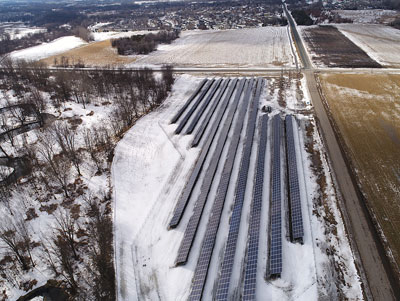Local governments and the Metropolitan Council have expanded the region’s solar capacity by an estimated 50 megawatts since 2015. Through a combination of on-site solar photovoltaic development and community solar garden subscriptions, that’s comparable to powering 8,100 Minnesota households, or about 20,300 people.
 Technical assistance from the Council has helped dozens of local governments in the seven-county metro area advance solar development. Recognizing the Council’s role, the national SolSmart program in September awarded the Council its top designation — Gold — for making it faster, easier, and more affordable for homes and businesses to adopt solar energy in the region.
Technical assistance from the Council has helped dozens of local governments in the seven-county metro area advance solar development. Recognizing the Council’s role, the national SolSmart program in September awarded the Council its top designation — Gold — for making it faster, easier, and more affordable for homes and businesses to adopt solar energy in the region.
The Council has advised more than 80 communities, including 16 SolSmart designees, offering resources and technical assistance on solar permitting, planning, and market development and finance.
“Solar energy is one tool in a wide array of options that local governments have for reducing greenhouse gas emissions and building resiliency to climate change,” said Cameran Bailey, Council planner and solar advisor to local governments. “It is a tool for economic development and realizing social and environmental justice.”
SolSmart is a national designation program recognizing cities, counties, and regional organizations that foster the development of mature local solar markets. It is led by the International City/County Management Association and funded by the U.S. Department of Energy’s Solar Energy Technologies Office.
The Council’s upgrade to Gold status is a result of its work engaging local utilities on goals for solar development and exploring areas for future collaborations. The award also recognizes Council assistance to five additional local governments that reached SolSmart designation earlier this year: Burnsville, Roseville, Eden Prairie, Mahtomedi, and Ramsey County. See map of SolSmart designees.
“Local governments are doing great work to advance solar,” Bailey said. “For example, the City of Burnsville developed outstanding solar energy system design guidelines (PDF) that other cities could easily adopt.”
SolSmart helps cities remove obstacles to solar development
Communities that enroll in SolSmart receive free technical assistance to become “open for solar business.” SolSmart awards cities, counties, and regional organizations points using objective criteria for removing obstacles to solar energy development — such as lack of appropriate construction codes, solar access ordinances, and permitting processes.
 “Nearly all metro area SolSmart-enrolled local governments are also enrolled in the state’s GreenStep Cities program, which helps cities set and achieve sustainability and quality-of-life goals,” Bailey said. “The programs complement each other well.”
“Nearly all metro area SolSmart-enrolled local governments are also enrolled in the state’s GreenStep Cities program, which helps cities set and achieve sustainability and quality-of-life goals,” Bailey said. “The programs complement each other well.”
State law requires local comprehensive plans to include “an element for the protection and development of access to direct sunlight for solar energy systems.” Bailey started at the Council as a contractor in April 2017, in a position funded by The Solar Foundation, McKnight Foundation, Great Plains Institute, and the Council to provide technical assistance on solar energy to local governments.
Based on high demand for the assistance, and to supply needed additional environmental planning capacity, the Council hired Bailey fulltime in November 2018 to support both needs.
Answering questions about solar development, leading workshops
In a typical day, Bailey answers questions from local governments on topics ranging from how much escrow to require for a solar development proposal to whether they can require pollinator-friendly planting in solar installations. His outreach schedule is busy as he serves on panels, leads workshops, and assists local advisory committees.
One feature of the Council’s online resources for communities is a solar resource map for every city and township in the region. The data from the maps can be used to estimate the total potential energy production of solar installations. The customized maps were clipped from the Minnesota Solar Suitability Analysis Map, developed by the University of Minnesota and maintained by the Minnesota Department of Commerce.
“Cities are finding that advancing solar development can attract young families for whom sustainability is a priority,” Bailey said. “Solar provides multiple benefits.”
Solar information and resources
Climate resilience information and resources